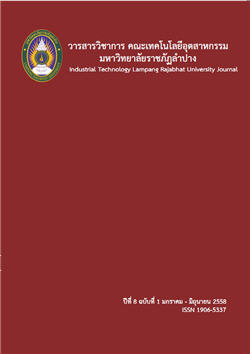การศึกษาเปรียบเทียบคุณสมบัติเหล็กน้ำพี้เชิงวิศวกรรม
DOI:
https://doi.org/10.14456/itjlp.2015.2Keywords:
เหล็กน้ำพี้แบบดั้งเดิม, เหล็กน้ำพี้แบบถลุงใหม่, คุณสมบัติเชิงวิศวกรรม, ปราชญ์ชาวบ้าน, ผู้รู้, traditional Nam Phi steel, newly smelted Nam Phi steel, engineering properties, village philosopher, guruAbstract
การวิจัยนี้ได้พบกระบวนการผลิตเหล็กน้ำพี้ในปัจจุบันของชุมชนน้ำพี้ ซึ่งผลิตเหล็กน้ำพี้ โดยการน้ำแร่เหล็กน้ำพี้มาถลุงในเตาที่พัฒนาขึ้นจากภูมิปัญญาของกลุ่มวิสาหกิจชุมชนดาบเหล็กน้ำพี้กับการวิจัย การลงพื้นที่วิจัยได้ชิ้นทดสอบตัวอย่างจำนวน 20 ชิ้น แบ่งเป็นเหล็กน้ำพี้แบบดั้งเดิมจำนวน 10 ชิ้น เหล็กน้ำพี้แบบถลุงใหม่จำนวน 10 ชิ้น จากนั้นได้ระบุรหัสของเหล็กน้ำพี้แบบดั้งเดิมระบุรหัส 101-105 กลุ่ม A ระบุรหัส 106-110 กลุ่ม B และเหล็กน้ำพี้แบบถลุงใหม่ระบุรหัส 201-205 กลุ่ม C ระบุรหัส 206-210 กลุ่ม D การวิจัยได้ทำการทดสอบการวิเคราะห์ผลการทดสอบความแข็งแบบวิกเกอร์ก่อนการชุบแข็งและหลังการชุบแข็ง โดยการทดสอบก่อนการชุบแข็งของกลุ่ม B และ D พบว่าเหล็กน้ำพี้แบบดั้งเดิมของกลุ่ม B มีค่าความแข็งสูงสุดเท่ากับ 180.00 HV ในชิ้นทดสอบที่ 106 และเหล็กน้ำพี้แบบถลุงใหม่ของกลุ่ม D มีค่าความแข็งสูงสุดเท่ากับ 293.67 HV ในชิ้นทดสอบที่ 208 ซึ่งพบว่าเหล็กน้ำพี้สภาพปกติก่อนการชุบแข็งเหล็กน้ำพี้แบบถลุงใหม่กลุ่ม D มีความแข็งมากกว่าเหล็กน้ำพี้แบบดั้งเดิมของกลุ่ม B
การทดสอบเหล็กน้ำพี้หลังการชุบแข็งที่อุณหภูมิ 850 องศาเซลเซียส ในสารจุ่มชุบน้ำ พบว่าเหล็กน้ำพี้แบบถลุงใหม่ในกลุ่ม C มีความแข็งสูงสุดเท่ากับ 839.67 HV ในชิ้นทดสอบที่ 205 เหล็กน้ำพี้ แบบดั้งเดิมในกลุ่ม A มีความแข็งสูงสุดเท่ากับ 319.67 HV ในชิ้นทดสอบที่ 101 จึงบอกได้ว่าเหล็กน้ำพี้แบบถลุงใหม่ในกลุ่ม C มีค่าความแข็งหลังการชุบแข็งที่ดีกว่าเหล็กน้ำพี้แบบดั้งเดิมในกลุ่ม A จึงเหมาะกับการนำไปใช้งานด้านวิศวกรรม
A Comparison of the Engineering Properties of Nam Phi Steel.
The research compares the properties of traditional Nam Phi steel with those of a steel produced in a new smelter. Twenty pieces of steel were used in the study, 10 of traditional Nam Phi steel and 10 pieces of the newly smelted Nam Phi steel. The 10 traditional Nam Phi steel pieces were divided into two groups and coded 101-105 for Group A and 106-110 for Group B. The 10 new Nam Phi steel pieces were also divided into two groups and encoded 201-205 for Group C and 206-210 for Group D. All twenty pieces were subjected to the Vickers hardness test for both pre- and post-hardening. The results for pre-hardening show that the maximum hardness of traditional Nam Phi steel was 180.00 HV (test piece 106) while the maximum hardness of the new Nam Phi steel was 293.67 HV (test piece 208). This showed that, for pre-hardening, the new Nam Phi steel of Group D was harder than traditional Nam Phi steel in Group B. After hardening at 850 degrees Celsius, it was found that the maximum hardness of items in Group C was 839.67 HV (test piece 205) while the maximum hardness of Group A was 319.67 HV (test piece 101). The new steel in Group D had higher levels of hardness after hardening than the traditional steel in Group A and so the new steel (Group D) was more suitable for engineering works.






